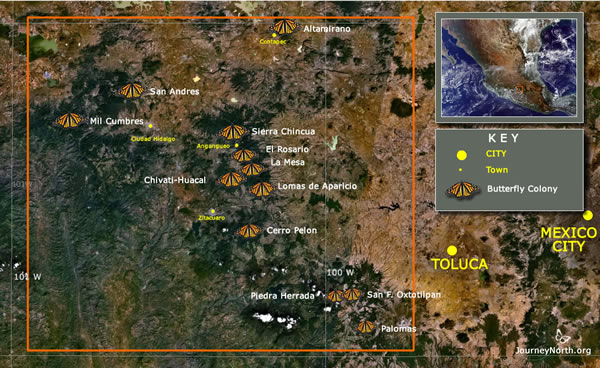"The trees look kind of mysterious. While one Oyamel trunk looks wrapped up in butterflies mainly at its middle, another tree trunk is completely bare with clusters hanging only on the branches," noted Estela at the Sierra Chincua Sanctuary.
Dear Friends, To start, I thought it important to take evidence of one single fact: Temperatures have been TOO HIGH for this time of year. Everyone around in town is commenting since we know it is not normal. Even in January some bright sunny days were reaching up to 22°C. How can the monarchs stand it? Let's hope it is more bearable for them in the forests. Now, to the Colonies’ behaviors this last days up to the past weekend. During the last weeks, both week days, but very specially at weekends, visitors from all over the world come in by hundreds and hundreds to even thousands during the 4-6 weekends prior to the end of the Monarchs’ season. Tourists go back simply delighted, and those visitors coming from far away countries are heard to tell each other, “No matter what the distance to come and see them, the trip has been worthwhile. This is everything we are here for." Colony at Sierra Chincua Sanctuary Colony at El Rosario Sanctuary Once at the core of the colony, one can notice how the colony has spread around. Clusters, though smaller, still look dense. Tree trunks look, similar than at Sierra Chincua, some rather densily covered with Monarchs at its mid height, others completely bare with clusters hanging, and some important massive-dense concentrations at the middle of several trees close together as if looking one single medium level-height brownish mass. All in all, an average of 50 Oyamel trees conforms this Colony at “Los Letreros”. The thermometer here, inside the Colony reads 7-8 Centigrades at about noon time. Monarchs are indeed somehow unpredictable. Everyone wanting to observe their continuous behavior should come every week, and those far away, should come every year, in order to see how they move on and overwinter day by day, winter after winter. While a week ago the colony looked gorgeous dense, being now located at “Los Letreros” site, it has now scattered visibly. The Colony is now divided into two main colonies, --local guides assure--, one in “Los Horcones” where they initially settled, and now this colony open for visitors at “Los Letreros”. Mating is still nowhere to be seen but it should be starting within the coming days; predation is very scarce as photos of areas in the ground show at both Sanctuaries. The atmosphere out of the Colony in Sanctuary El Rosario—the biggest Monarch Colony of all— is very lively and colorful; the facilities have been now completely re-built into around 100 commerce spaces which will very soon be finished, and which are now the new restaurants and souvenirs stores. We should continue to observe Monarchs behavior closely; weather behavior should most likely determine their moving, their mating stage and their preparing for their leaving within the coming weeks. Until next week, Estela Romero |
|
|||||||||||||||||||
Copyright Journey North (journeynorth.org). All Rights Reserved.








